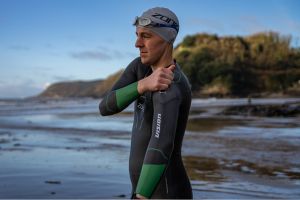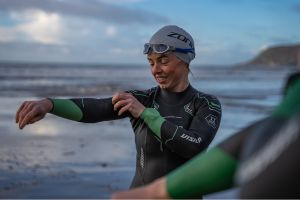Introduction:
With swimming pools closed to the public and lakes and beaches now a little bit more accessible under new lockdown rules – you may be thinking about venturing into the open waters to get back to your training. Or, perhaps, you’re looking to get into open water swimming for the first time.
Open water swimming brings many health benefits, including better sleep, better circulation, improved mental health, increased metabolism, and a boosted immune system. It also brings the opportunity to enjoy the great outdoors and experience a side of nature you might not have before. Open water swimming is also great for mental health, as its relaxing, increases the production of positive hormones in the brain and can be highly rewarding.
Before jumping into your nearest open water venue please check the relevant guidance found here:
You’ll also need the following Zone3 equipment:
A Wetsuit

Swimming wetsuits differ from other water sports wetsuits. Surfing wetsuits are designed to provide insulation and are made with thicker materials whereas swimming wetsuits are made with thinner materials, differing levels of buoyancy and have a much higher flexibility range, allowing for more freedom of movement. You’ll find it incredibly difficult to swim for long periods of time in a surfing wetsuit, so we recommend the following:
For beginners:
The Advance Wetsuit is an entry-level wetsuit that features high-quality neoprene materials not often seen in wetsuits designed for entry-level swimmers. With Free Flex lining on the underarms, this suit provides the right amount of flexibility, buoyancy and energy conservation for swimmers making the transition from pools to open waters.
The Vision Wetsuit is a step up from the advance and can also be used as a training suit for the more experienced triathlete. It is also known as being the fastest entry-level wetsuit on the market. The Vision takes inspiration from other Zone3 wetsuits designed for professional swimmers, and is made to minimise drag in the water, provide great flexibility, and reach throughout the torso and helps save time and energy whilst reducing fatigue. The rear panel is also highly reflective – a great safety feature for being easy to spot in open water, particularly on solo swims in the sea.
For intermediate and competent swimmers:
The Aspire Wetsuit is for those wanting more buoyancy. The Aspire features 30% more buoyancy than standard neoprene wetsuits and provides increased flexibility and distance per stroke. It’s a great suit for beginners all the way up to professionals, due to its adaptability in the water.
The Vanquish Wetsuit is a suit that is loved by professional swimmers such as Josh Amberger and Tim Don. The Vanquish is our highest rated wetsuit and is notably for swimmers wanting to shave minutes off their swim time. The Vanquish ensures maximum flexibility and an improved catch in the water, reduces arm fatigue, and increases efficiency in the water and gives swimmers ultimate freedom of movement.
Other items you’ll need for open water swimming include:
Goggles

A good pair of goggles are absolutely crucial for open water swimming as you’ll really need to protect your eyes in the water and be able to swim without risk of fogged up lenses. Some goggles are suitable only for pool swimming and won’t provide much protection in open waters, so you’ll need to bear this in mind when goggle shopping. Our top picks for open water goggles are:
These are great for both indoor and outdoor swimming, with ultra-soft silicone gaskets, anti-fog treated lenses with 100% UVA/UVB protection, large curved lenses for sighting, easily adjustable straps, and both polarised and photochromatic lenses.
Again, these are suitable for both pool and open water swimming, with lucid crystal-clear lenses with mirrored or clear finish, a hydro-dynamic design for fast, streamlined swimming, horizon wide-angle lenses for super vision, quick-fit strap adjustment system for an easy, secured fit, soft silicone gaskets for comfort and protection and 100% UVA/UVB protection with anti-fog treatment
Attack Goggles
Built to be flexible, these goggles conform to a wide variety of face and head shapes, with curved lenses for enhanced vision, polarized and photochromatic anti-fog treated lenses and a flexible soft silicone frame.
Safety Accessories

Keeping safe in the water is an absolute must, which is why we’ve produced a number of products designed to keep you safe, seen and comfortable in the water.
Items such as the Swim Safety Buoy/Dry Bag 28L, the Swim Safety Buoy/Hydration Control or the Swim Safety Belt with Tow Float Pouch are essential for keeping afloat in the water, with pockets to keep items in, and come in neon colourways, to ensure you can be spotted by other swimmers and those on shore. Safety floats are encouraged for beginners as having this device with you can really put your mind at ease.
These brightly coloured Zone3 Swim Caps come in an array of neon colourways, to make sure you’re easily spotted in the water. Bright swim caps are recommended and encouraged by swim safety expects and the Zone3 swim caps are durable, comfortable, and lightweight.
Other accessories
For comfort, you may want to invest in other accessories such as a waterproof swim bag, spare towels, or a fleece lined parka robe to keep warm in after your swim. If you don’t enjoy the cold or briskness of open waters, you also might want to try our neoprene accessories such as the Neoprene Swim Cap, Neoprene Swim Gloves or Neoprene Swim Socks which are designed to provide and maintain insulation to keep your extremities warm.
The main differences between pool swimming and open water swimming is the lack of ability to push off of walls, not having swim lanes to guide you in the right direction and not being able to touch the bottom. These are all differences that with time, you can learn to adjust to. You can adjust to the differences by adapting the following techniques:
Sighting
As mentioned before, in open waters there are no swim lanes or lane lines guiding you in the right direction. To be able to guide yourself in the open water, you’ll need to learn how to sight. This just means practicing looking ahead during your swim to find a ‘marker’ in the distance to guide you. Most people spot a tree, or a small landmark, and use that as guidance on where to swim to. You can practice this in a pool by focusing on a spot on the wall at the end of the lane you’re in and focusing on that spot only. Another way to train in a pool for open water swimming is to try and swim in a straight line as much as possible. In open water triathlons, you’re bound to veer left or right and bump into other triathletes, so getting this spot on in the pool whilst you can is a good idea. If practicing this for the first time in open waters, swim close to the shore line until you’ve got it right and then go further into the water.
Treading water
There are no walls to kick off of or swim to in open water. You’ll probably find yourself treading water a lot when in a lake, or the sea, so it’s best to practice treading water in the deep end of the swimming pool.
Turning
Often, open water events require participants to turn around a water buoy, sometimes more than once in a race. You can train for this in open water once you’re confident, but it’s a good idea to try this in a pool as well – if you have space. When practicing this in a pool, make sure you’re not touching walls or the bottom of the swimming pool. In open water, practice this by swimming around water buoys, if safe to do so, or if you’re swimming with a friend, use each other as markers to swim around.
Breathing
In open waters, breathing on alternative sides is the most suggested breathing technique. It probably won’t feel natural to begin with, so practicing this in a pool is the best bet. It’s recommended that you learn how to breathe away from the direction of the waves to reduce water intake.
If bilaterally breathing, rotate your head and spine with your shoulders, breath in and then turn your face along with your next shoulder rotation.
Essentially, the easiest way to breathe in open water, is to inhale through your mouth and exhale when your head is submerged without breathing to the side. Do whatever feels most natural to you and what you’re most confident with. It’s a good idea to try lots of different techniques during training and recognise that when you’re swimming at different speeds and intensities, your preferred breathing technique will change to accommodate that.

Swim Technique
In open water, you’ll need a stroke with a slightly higher stroke rate than in the pool. This helps you keep momentum if you’re in choppy waters.
Most open water swimmers opt for the front crawl, so it’s a good idea to make sure you’re familiar with this stroke and can maintain it for longer periods of time. You need to be comfortable with whatever strokes you choose.
It’s recommended you get used to other techniques, such as breaststroke, as this uses less energy than front crawl and you may find yourself in a situation where all you can manage at that time is a breaststroke.





















